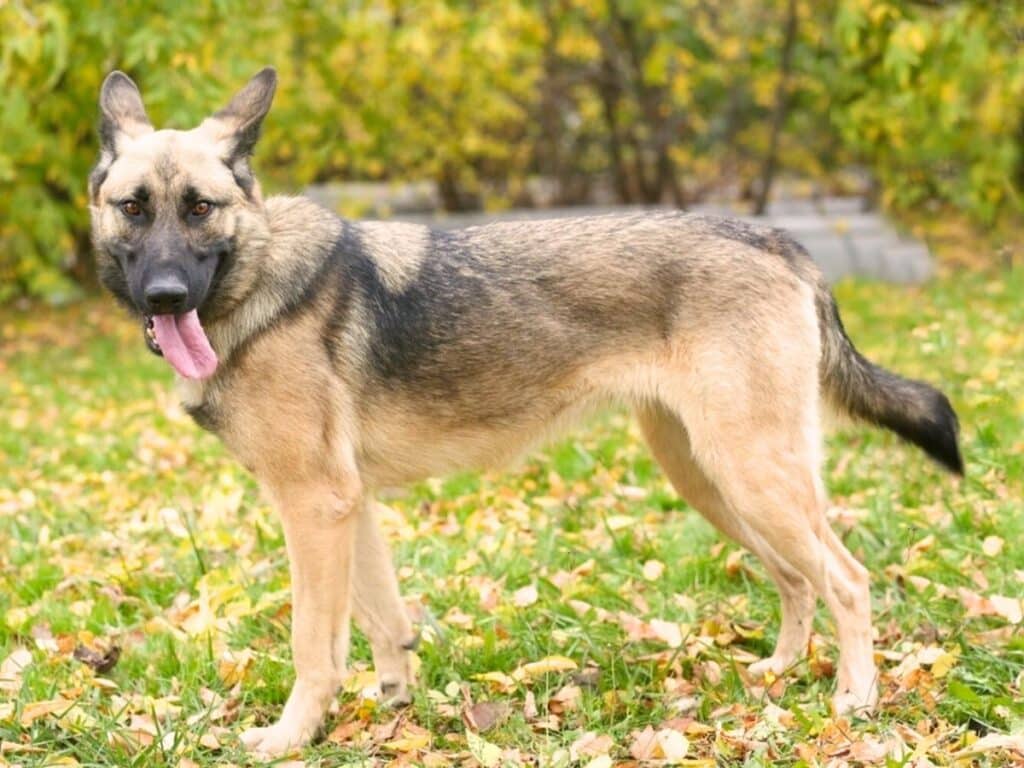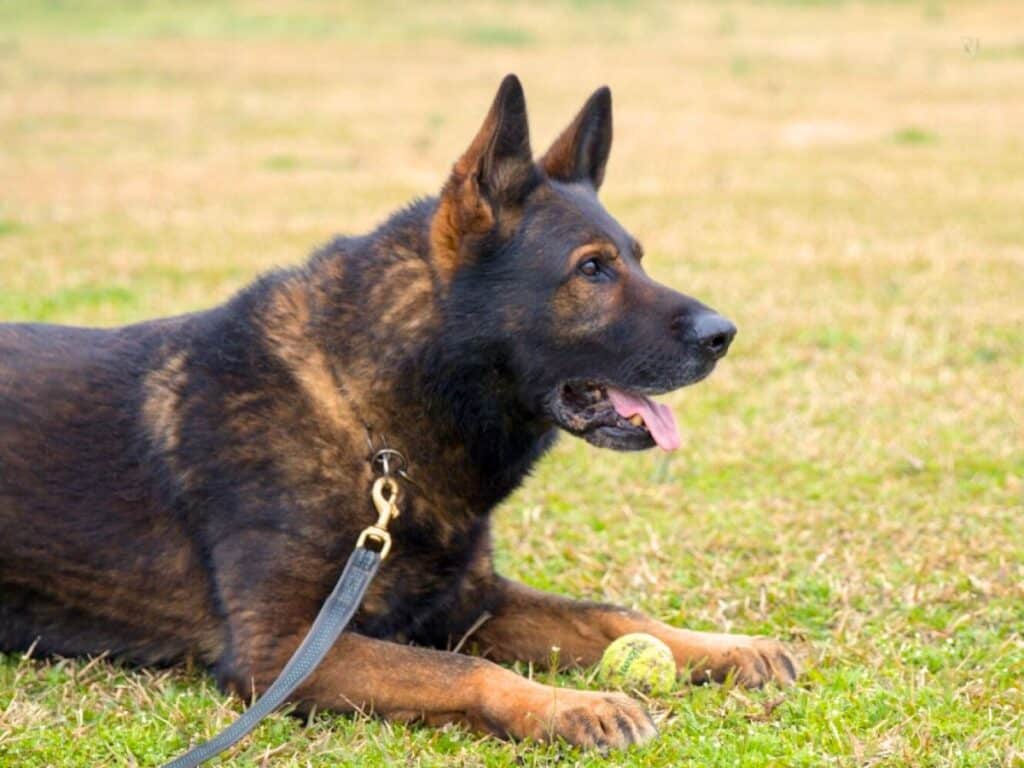Do you often look at your GSD and wonder “Why is my German Shepherd so small?”
It’s a common concern among GSD owners, but there are many factors that can influence the size of a German Shepherd.
German Shepherd puppies are typically born small and grow rapidly in their first few months.
However, the size of a fully-grown German Shepherd dog can be influenced by genetics, nutrition, and health issues. In some cases, a German Shepherd may be smaller due to being a mixed breed or having dwarfism.
So in this article, we’ll cover all the essential information you need to know as a responsible small GSD owner, from understanding dogs’ genetics to providing proper nutrition to them.
So why is your German Shepherd so small? Let’s dive into the details and find out.
Why is my German Shepherd so Small? 10 Reasons
1. Genetics: The Primary Determinant of Size
The breed standard for German Shepherds specifies a height range of 22 to 26 inches at the shoulder, with males typically being larger than females.
The size of a German Shepherd is primarily influenced by the genes inherited from its parents.
If both parents are smaller in size, it increases the likelihood that their offspring will also be smaller.

However, it’s important to note that genetics is a complex interplay of various factors, and predicting the exact size of a puppy based solely on the parents’ size is not always straightforward.
In the breeding process, responsible breeders strive to produce German Shepherds that adhere to the breed standard, which includes guidelines for size.
However, it’s not uncommon to see natural variations in size among individual dogs, even within a well-bred litter.
It’s worth mentioning that there are different lines within the German Shepherd breed, such as working lines and show lines.
Working-line German Shepherds, which are bred for their working abilities, tend to have a leaner and more athletic build compared to show line German Shepherds, which are bred with an emphasis on conforming to the breed standard.
This distinction can also contribute to variations in size between individual German Shepherds.
2. Poor Nutrition: A Common Cause of Stunted Growth
Another common cause of small size in German Shepherds is poor nutrition during the puppy stage.
German Shepherds, especially during their growth stages, require a balanced and sufficient amount of calories to support their rapid growth.
If a dog does not receive enough calories through their diet, it can potentially impact its growth and result in a smaller size.
Similarly, overfeeding can lead to excessive weight gain, which may affect the dog’s overall size and development.
A German Shepherd’s diet should provide a proper balance of essential nutrients, including proteins, fats, carbohydrates, vitamins, and minerals.
These nutrients are essential for healthy growth and development. Inadequate intake of specific nutrients, such as protein, can hinder muscle development and overall size.
We will discuss more on proper nutrition for your GSD later in this article.
RELATED: Why Is My German Shepherd So Skinny? How To Fatten Them Up
3. Overbreeding and Inbreeding: A Dangerous Practice
Overbreeding and inbreeding are practices that can result in smaller-sized German Shepherds with health problems.
Overbreeding refers to breeding dogs too frequently, which can lead to genetic defects and other issues.
Inbreeding involves breeding closely related dogs, such as siblings or parent-offspring pairs.
This can increase the likelihood of genetic disorders and decrease genetic diversity within the breed.
If you are considering purchasing a German Shepherd, make sure to do your research on the breeder and ask about their breeding practices.
Avoid breeders who engage in overbreeding or inbreeding as this can lead to serious health problems for your dog.
4. Environmental Factors: Lack of Exercise and Exposure to Toxins

Environmental factors such as lack of exercise and exposure to toxins can also affect a German Shepherd’s growth and size.
Dogs that do not get enough exercise may be more prone to weight gain and stunted growth due to lack of muscle development.
Exposure to toxins such as pesticides, herbicides, or other chemicals can also have adverse effects on your dog’s growth and development.
Make sure to keep your dog away from areas where these substances are present, such as lawns that have been treated with chemicals.
5. Dwarfism or Achondroplasia
Dwarfism or achondroplasia can indeed be a reason for a German Shepherd to be smaller in size.
Achondroplasia is a genetic condition that affects bone growth and development, resulting in shorter limbs and overall stature.
In German Shepherds, achondroplasia is a relatively rare condition but can occur due to spontaneous genetic mutations.
Dogs with achondroplasia will typically have shorter legs and a compact body structure compared to their standard-sized counterparts.
This condition is often referred to as “dwarfism” or “chondrodysplasia.”
It’s important to note that achondroplasia in German Shepherds is considered a fault according to breed standards, as it deviates from the desired conformation and working abilities of the breed.
Responsible breeders strive to avoid breeding dogs with this condition to maintain the breed’s integrity and overall health.
If you suspect that your German Shepherd has achondroplasia, it’s best to consult with a veterinarian for a proper diagnosis and guidance on how to provide the best care for your dog’s specific needs.
RELATED: Dwarf German Shepherd: Pictures, Traits & Price
6. Your GSD may be a Mixed Breed or a Variation
Mixed breed dogs or variations within the German Shepherd breed can contribute to a smaller size in German Shepherds.
When a German Shepherd is bred with another breed or if there are variations within the German Shepherd breed itself, it can result in offspring that are smaller in size.
When a German Shepherd is crossed with another breed, the size genes from both parents can combine in unpredictable ways.
Depending on the size-genes inherited from the parent breeds, the resulting mixed breed puppies may be smaller than a purebred German Shepherd.
Health Issues: Possible Causes of Smallness in German Shepherds

While some dogs are naturally small, it’s possible that health issues could be causing your German Shepherd’s stunted growth.
7. Intestinal Parasites
One common cause of smallness in dogs is intestinal parasites.
These parasites can affect a dog’s growth and development by interfering with its ability to absorb nutrients from its food.
If left untreated, these parasites can lead to malnutrition and other health problems.
To determine if your dog has intestinal parasites, your veterinarian will need to perform a fecal exam.
If your dog tests positive for parasites, they will prescribe medication to eliminate them.
It’s important to follow the medication regimen as prescribed and make sure your dog receives regular check-ups to monitor their progress.
8. Thyroid Problems and Malabsorption
Thyroid problems and malabsorption are two health issues that can cause a German Shepherd to be smaller than average.
Thyroid problems can affect metabolism and lead to weight gain or loss depending on whether they are overactive or underactive.
Malabsorption occurs when the body is unable to absorb nutrients from food properly.
This condition can lead to weight loss and stunted growth in German Shepherds.
If you suspect that your dog has either thyroid problems or malabsorption, take them to the veterinarian for a checkup.
Treatment may involve medication or changes in diet to address the underlying issue.
9. Illnesses
Illnesses like hip dysplasia can also impact a dog’s growth and result in a smaller size than expected.
Hip dysplasia is a condition where the ball and socket joint of the hip don’t fit together properly.
This can cause pain and discomfort for the dog, which can lead to a decreased appetite and poor growth.
If your German Shepherd has hip dysplasia, your veterinarian may recommend surgery or other treatments to alleviate their symptoms.
It’s important to follow your vet’s recommendations and provide your dog with the necessary care to manage their condition.
10. Anxiety
Anxiety is another factor that can impact a dog’s growth and development.
If your German Shepherd is anxious or stressed, they may not eat as much as they should, which can lead to stunted growth.
Anxiety can cause dogs to be less active, which can also contribute to poor growth.
To help reduce anxiety in your dog, it’s important to identify the source of their stress and address it appropriately.
For example, if your dog is anxious around other dogs, you may need to work on socialization training.
You may also consider talking with your veterinarian about anti-anxiety medication for your dog.
RELATED: How To Help Your GSD Overcome Separation Anxiety
Understanding GSD Growth Rate

Understanding the growth rate of German Shepherds is important for their overall development and well-being. Here are some key points to consider:
A GSD growth chart can help you track your pup’s progress and ensure they are growing at a healthy rate.
A GSD growth chart provides an estimate of how much your puppy should weigh at different stages of development.
This chart takes into account various factors such as gender, genetics, nutrition intake, and physical activity levels.
At one-month-old, a male German Shepherd puppy should weigh around 10 pounds while females should weigh around 8 pounds on average.
By three months old males should weigh between 25-35 pounds while females should weigh between 20-30 pounds on average.
At six months old, males should weigh between 50-65 pounds while females should weigh between 40-55 pounds on average.
It’s important to remember that these numbers are just estimates and not exact measurements.
Every dog is unique, and their growth rate may vary depending on various factors such as genetics, nutrition, and exercise levels.
For a more in-depth look at phases and what behavior and physical changes a GSD puppy goes through, have a look at our German Shepherd growth chart.
It’s common for puppies to experience a growth spurt between 3-5 months of age.
German Shepherd puppies typically experience a growth spurt around three to five months of age.
During this time, they may gain weight rapidly and appear lanky or awkward as their bodies adjust to the changes in size.
This is completely normal and nothing to be concerned about.
During this period, it’s essential to ensure your puppy receives proper nutrition and exercise.
You can increase their food intake slightly during this stage but avoid overfeeding them as it can lead to health problems later on.
Growth plate closure
Growth plate closure is an essential process in the development of a German Shepherd or any other dog breed.
Growth plates, also known as epiphyseal plates, are areas of cartilage located near the ends of long bones in growing puppies.
During the growth phase, the growth plates are responsible for the lengthening and shaping of the bones.
As the puppy grows, the cartilage in the growth plates gradually transforms into bone, and this process is known as ossification.
Once the growth plates completely ossify, they are considered closed.
The closure of the growth plates is an essential milestone in a German Shepherd’s development.
It indicates that the dog has reached skeletal maturity, and further bone growth in terms of length is limited.
After growth plate closure, the dog’s bones can still continue to develop in terms of filling out and muscle development, but they will no longer grow longer.
Feeding Your German Shepherd To Address Smallness

1. Adjust Calorie Intake Based on Activity Levels
German Shepherds are known for their high energy levels and require a lot of exercise to maintain their health.
As a result, it’s essential to adjust your dog’s calorie intake based on their activity levels.
A sedentary lifestyle may require fewer calories than an active one, so it’s crucial to monitor your dog’s activity level and adjust its diet accordingly.
If your German Shepherd is highly active, they will need more calories to fuel their energy demands.
You can increase the number of meals you feed them per day or add in some healthy snacks to help them meet their needs.
However, if your dog is less active, you should reduce the number of calories they consume.
It’s important to note that feeding your German Shepherd too many calories can lead to obesity and related health issues such as joint problems, diabetes, and heart disease.
Therefore, it’s crucial to find the right balance between calorie intake and physical activity.
2. Importance of a Balanced Diet
German Shepherds are known to be one of the largest dog breeds, with an average weight of 50-90 pounds.
However, some owners may notice that their German Shepherd is smaller than expected. One reason this could happen is due to poor nutrition.
A balanced diet that provides the right amount of nutrients is crucial for large-breed dogs to grow and develop properly.
It’s important to choose a high-quality dog food that meets their specific nutritional needs.
Look for dog food brands that offer a high percentage of animal-based protein sources, such as chicken, beef, or fish.
Foods like eggs and yogurt are great sources of additional protein.
Avoid feeding your dog fatty table scraps or unhealthy treats. Instead, opt for healthier options like coconut oil or salmon oil.
These types of oils contain omega-3 fatty acids that can help improve skin and coat health while also promoting weight gain.
Make sure the food you choose has controlled levels of calcium and phosphorus since excessive amounts can lead to bone growth issues in large-breed dogs.
3. Choose Dog Food Specially Formulated for Large-breed Dogs
Large breed dogs require different types of diets compared to smaller breeds because they grow at a much faster rate during puppyhood. (Source)
That’s why many dog food brands offer specific formulas for large-breed dogs that are formulated with the right balance of nutrients.
In addition to controlled levels of calcium and phosphorus, large-breed dog food also contains higher levels of glucosamine and chondroitin which support joint health.
These ingredients help prevent joint problems such as hip dysplasia which is common in German Shepherds.
Check out this article that can help you determine the appropriate amount of food for your German Shepherd, considering factors such as age, weight, activity level, and specific dietary needs.
4. Increase the Amount of Food Gradually
While it may be tempting to increase the amount of food you give your dog all at once, doing so can lead to digestive problems or even obesity.
Instead, gradually increase the amount of food you give them over time.
Start by adding an extra half-cup of food per meal every few days until they reach their desired weight.
It’s also essential to monitor your dog’s body condition score (BCS) regularly to ensure they’re not gaining too much weight too quickly.
5. Overfeeding Can Lead To Obesity And Health Issues
Overfeeding your German Shepherd can lead to obesity, which is a common health issue in this breed.
Obesity can cause several health problems, including joint issues, heart disease, and diabetes.
It’s essential to monitor your dog’s weight regularly and adjust its diet accordingly to maintain a healthy weight range.
If you notice that your German Shepherd is gaining weight or becoming overweight, it may be time to reduce their calorie intake or increase their physical activity level.
6. Consult With A Veterinarian To Determine The Appropriate Diet
Consulting with a veterinarian who specializes in canine nutrition is the best way to determine the appropriate diet for your German Shepherd’s individual needs.
They can provide guidance on the right type of food, portion sizes, and feeding frequency based on factors such as age, weight, body condition score (BCS), and activity level.
In addition to dry kibble or wet food options available at pet stores or online retailers, there are many other options for feeding your German Shepherd.
For example, raw food diets have become increasingly popular among pet owners who prefer a more natural approach to feeding their dogs.
However, it’s important to note that not all raw food diets are created equal and may not meet all of your dog’s nutritional needs.
Therefore, it’s crucial to consult with a veterinarian before switching over to any new diet plan.
How big do German Shepherds get?

German Shepherds are a popular breed of dog, known for their intelligence, loyalty, and versatility.
One common question that many owners have is how big their German Shepherd will grow to be.
According to the breed standard, male German Shepherds should stand between 24-26 inches tall at the shoulder, while females should be slightly smaller at 22-24 inches. (AKC)
It’s important to note that these height ranges are just guidelines and deviations from them do not necessarily indicate a health problem or inferiority in the dog’s quality.
Factors such as genetics, nutrition, and exercise can all play a role in determining a German Shepherd’s ultimate size and height.
While it’s essential to have an understanding of your dog’s breed standardsIt’s also crucial to remember that these standards aren’t set in stone.
Deviations from these guidelines don’t mean your dog is unhealthy or less valuable than others who fit within those ranges.
When do German Shepherds Stop Growing?
German Shepherds typically stop growing in terms of height and bone development between 12 to 18 months of age.
This is when the growth plates in their bones close, and further increase in height is limited.
However, it’s important to note that while the height growth stops around this time, German Shepherds may continue to fill out and develop muscle mass for several more months or even up to their third year.
The exact timing of when a German Shepherd reaches their full size and maturity can vary between individuals.
Factors such as genetics, nutrition, and overall health can influence the rate and duration of their growth.
Male German Shepherds may take longer to reach full skeletal maturity compared to females.
RELATED: When Do German Shepherds Stop Growing?
How to Get Your German Shepherd to Be Bigger
Understanding the Breed Standard for German Shepherds
German Shepherds are a large breed of dogs that can weigh anywhere from 50 to 90 pounds and stand up to 26 inches tall at the shoulder.
However, it’s important to note that not all German Shepherds are the same size.
The breed standard for German Shepherds varies depending on where you live in the world.
For example, in Germany, the breed standard calls for a slightly different look than in America or Canada.
When looking at your GSD puppy, it’s important to consider its genetics and breeding.
Some GSDs may be smaller than others due to their lineage, while others may grow larger due to their genes.
Some GSDs may have health issues that affect their growth rate.
Large Breeds Like German Shepherds Take Longer to Reach Full Size
Large breeds like German Shepherds may take longer to reach their full size compared to smaller breeds of dogs.
It’s not uncommon for a GSD puppy to continue growing until they’re two years old or more.
During this time, it’s essential that your GSD gets proper nutrition and exercise so they can reach their full potential size.
Proper Nutrition and Exercise Can Help Your GSD Reach Their Full Potential Size
To help your GSD reach its full potential size, ensure they get proper nutrition and exercise.
A healthy diet is crucial as overfeeding can lead to health problems such as obesity or joint pain.
Talk with your veterinarian about what kind of food is best for your pup based on its age, weight, activity level, and overall health.
Exercise is also critical for helping your GSD grow big and strong! Regular walks or runs will help keep them active while also burning off excess energy that could contribute towards destructive behavior at home.
Consult With a Veterinarian or Breeder to Ensure Your GSD Is Healthy and Growing at a Normal Rate
Regular check-ups with your veterinarian are essential for ensuring your GSD is healthy and growing at a normal rate.
They can help identify any health issues that may be affecting your puppy’s growth and provide advice on how to address them.
Consulting with the breeder you got your puppy from can also be helpful as they have experience with the breed and can offer guidance on what to expect in terms of size.
Remember That the Most Important Thing Is That Your GSD Is Healthy and Happy
While some people prefer big dogs, it’s important to remember that the most important thing is that your GSD is healthy and happy.
Don’t get too caught up in trying to make your dog bigger than they were meant to be!
Instead, focus on providing them with love, attention, proper nutrition, exercise, and medical care.
Conclusion
I hope this post has answered your question “ Why is my German Shepherd so small?”. If you’re concerned about your German Shepherd’s size, there are a variety of factors that could be contributing to their smallness.
Factors like feeding habits, genetics, and health issues can all affect your dog’s size. It’s important to feed them a balanced diet tailored to their activity levels and nutritional needs.
Monitoring for signs of anxiety or intestinal parasites can help identify any underlying health issues that may be causing smallness.
If you’re looking to increase your German Shepherd’s weight safely, it’s important to do so gradually and with proper nutrition.
Overfeeding or providing too many treats can lead to obesity and other health problems down the line.
Overall, if you have concerns about your German Shepherd’s size it’s important to consult with a veterinarian who can provide guidance on how best to address these issues.
Frequently Asked Questions (FAQs)
1. How much should my month-old German Shepherd weigh?
At one month old, a male German Shepherd puppy should weigh between 9-15 pounds while females should weigh between 7-13 pounds. Keep in mind that individual puppies may vary slightly from these averages based on genetics and other factors.
2. Is my German Shepherd’s size normal?
The ideal weight range for adult male German Shepherds is 65-90 pounds while females should weigh between 50-70 pounds. If your dog falls outside of this range it may be worth consulting with a veterinarian to ensure there are no underlying health issues contributing to their size.
3. What are some reasons for smallness in German Shepherds?
Genetics, breeding practices, feeding habits, and health issues can all contribute to smallness in German Shepherds. If you’re concerned about your dog’s size it’s important to consider all of these factors.
4. How can I help my German Shepherd gain weight safely?
Increasing your dog’s food intake gradually and providing a balanced diet tailored to their activity levels is key. Monitoring their body condition regularly and avoiding overfeeding or too many treats can help prevent obesity and other health problems.
5. What should I do if I’m still concerned about my German Shepherd’s size?
If you’re still worried about your dog’s size after considering the above factors, it may be worth consulting with a veterinarian who can provide guidance on how best to address these concerns.




